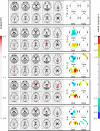The crossroads of anxiety: distinct neurophysiological maps for different symptomatic groups
- PMID: 26848265
- PMCID: PMC4723020
- DOI: 10.2147/NDT.S89651
The crossroads of anxiety: distinct neurophysiological maps for different symptomatic groups
Abstract
Background: Despite the devastating impact of anxiety disorders (ADs) worldwide, long-lasting debates on causes and remedies have not solved the clinician's puzzle: who should be treated and how? Psychiatric classifications conceptualize ADs as distinct entities, with strong support from neuroscience fields. Yet, comorbidity and pharmacological response suggest a single "serotonin dysfunction" dimension. Whether AD is one or several disorders goes beyond academic quarrels, and the distinction has therapeutic relevance. Addressing the underlying dysfunctions should improve treatment response. By its own nature, neurophysiology can be the best tool to address dysfunctional processes.
Purpose: To search for neurophysiological dysfunctions and differences among panic disorder (PD), agoraphobia-social-specific phobia, obsessive-compulsive disorder (OCD) and generalized anxiety disorder.
Methods: A sample population of 192 unmedicated patients and 30 aged-matched controls partook in this study. Hypothesis-related neurophysiological variables were combined into ten independent factors: 1) dysrhythmic patterns, 2) delta, 3) theta, 4) alpha, 5) beta (whole-head absolute power z-scores), 6) event-related potential (ERP) combined latency, 7) ERP combined amplitude (z-scores), 8) magnitude, 9) site, and 10) site of hyperactive networks. Combining single variables into representative factors was necessary because, as in all real-life phenomena, the complexity of interactive processes cannot be addressed through single variables and the multiplicity of potentially implicated variables would demand an extremely large sample size for statistical analysis.
Results: The nonparametric analysis correctly classified 81% of the sample. Dysrhythmic patterns, decreased delta, and increased beta differentiated AD from controls. Shorter ERP latencies were found in several individual patients, mostly from the OCD group. Hyperactivities were found at the right frontorbital-striatal network in OCD and at the panic circuit in PD.
Conclusions: Our findings support diffuse cortical instability in AD in general, with individual differences in information processing deficits and regional hyperactivities in OCD and PD. Study limitations and the rationale behind the variable selection and combination strategy will be discussed before addressing the therapeutic implications of our findings.
Keywords: EEG; ERP; LORETA; anxiety disorders; dysrhythmic; epileptiform.
Figures





Similar articles
-
Panic Disorder and Agoraphobia in OCD patients: clinical profile and possible treatment implications.Compr Psychiatry. 2014 Apr;55(3):588-97. doi: 10.1016/j.comppsych.2013.11.017. Epub 2013 Nov 27. Compr Psychiatry. 2014. PMID: 24374170
-
[Validation of a scale for responsibility (Salkovskis Responsibility Scale)].Encephale. 2001 May-Jun;27(3):229-37. Encephale. 2001. PMID: 11488253 French.
-
Duration of untreated illness in a cross-diagnostic sample of obsessive-compulsive disorder, panic disorder, and social anxiety disorder.CNS Spectr. 2019 Oct;24(5):526-532. doi: 10.1017/S1092852918001281. CNS Spectr. 2019. PMID: 30419984
-
[Efficacy and tolerability of escitalopram in anxiety disorders: a review].Encephale. 2008 Sep;34(4):400-8. doi: 10.1016/j.encep.2008.04.004. Epub 2008 Aug 15. Encephale. 2008. PMID: 18922243 Review. French.
-
Long-term Outcomes of Cognitive Behavioral Therapy for Anxiety-Related Disorders: A Systematic Review and Meta-analysis.JAMA Psychiatry. 2020 Mar 1;77(3):265-273. doi: 10.1001/jamapsychiatry.2019.3986. JAMA Psychiatry. 2020. PMID: 31758858 Free PMC article.
Cited by
-
Shortened questionnaires to assess anxiety and depression during in-hospital rehabilitation: clinical validation and cutoff scores.Neuropsychiatr Dis Treat. 2016 Oct 12;12:2627-2633. doi: 10.2147/NDT.S111797. eCollection 2016. Neuropsychiatr Dis Treat. 2016. PMID: 27789951 Free PMC article.
-
Resting-state theta band connectivity and graph analysis in generalized social anxiety disorder.Neuroimage Clin. 2016 Nov 12;13:24-32. doi: 10.1016/j.nicl.2016.11.009. eCollection 2017. Neuroimage Clin. 2016. PMID: 27920976 Free PMC article.
-
Transdiagnostic Symptom Clusters and Associations With Brain, Behavior, and Daily Function in Mood, Anxiety, and Trauma Disorders.JAMA Psychiatry. 2018 Feb 1;75(2):201-209. doi: 10.1001/jamapsychiatry.2017.3951. JAMA Psychiatry. 2018. PMID: 29197929 Free PMC article.
References
-
- Revicki DA, Travers K, Wyrwich KW, et al. Humanistic and economic burden of generalized anxiety disorder in North America and Europe. J Affect Disord. 2012;140(2):103–112. - PubMed
-
- World Health Organization . The ICD 10 Classification of Mental and Behavioral Disorders: Clinical Description and Diagnostic Guidelines. Geneva: World Health Organization; 1992.
-
- American Psychiatric Association . Diagnostic and Statistical Manual for Mental Disorders. 5th ed. Washington, DC: American Psychiatric Association Press; 2013.
-
- Lang PJ, Davis M, Ohman A. Fear and anxiety: animal models and human cognitive psychophysiology. J Affect Disord. 2000;61(3):137–159. - PubMed
LinkOut - more resources
Full Text Sources
Other Literature Sources

